Cluster BMW 4 SERIES GRAN COUPE 2016 F36 Owner's Guide
[x] Cancel search | Manufacturer: BMW, Model Year: 2016, Model line: 4 SERIES GRAN COUPE, Model: BMW 4 SERIES GRAN COUPE 2016 F36Pages: 249, PDF Size: 5.3 MB
Page 103 of 249
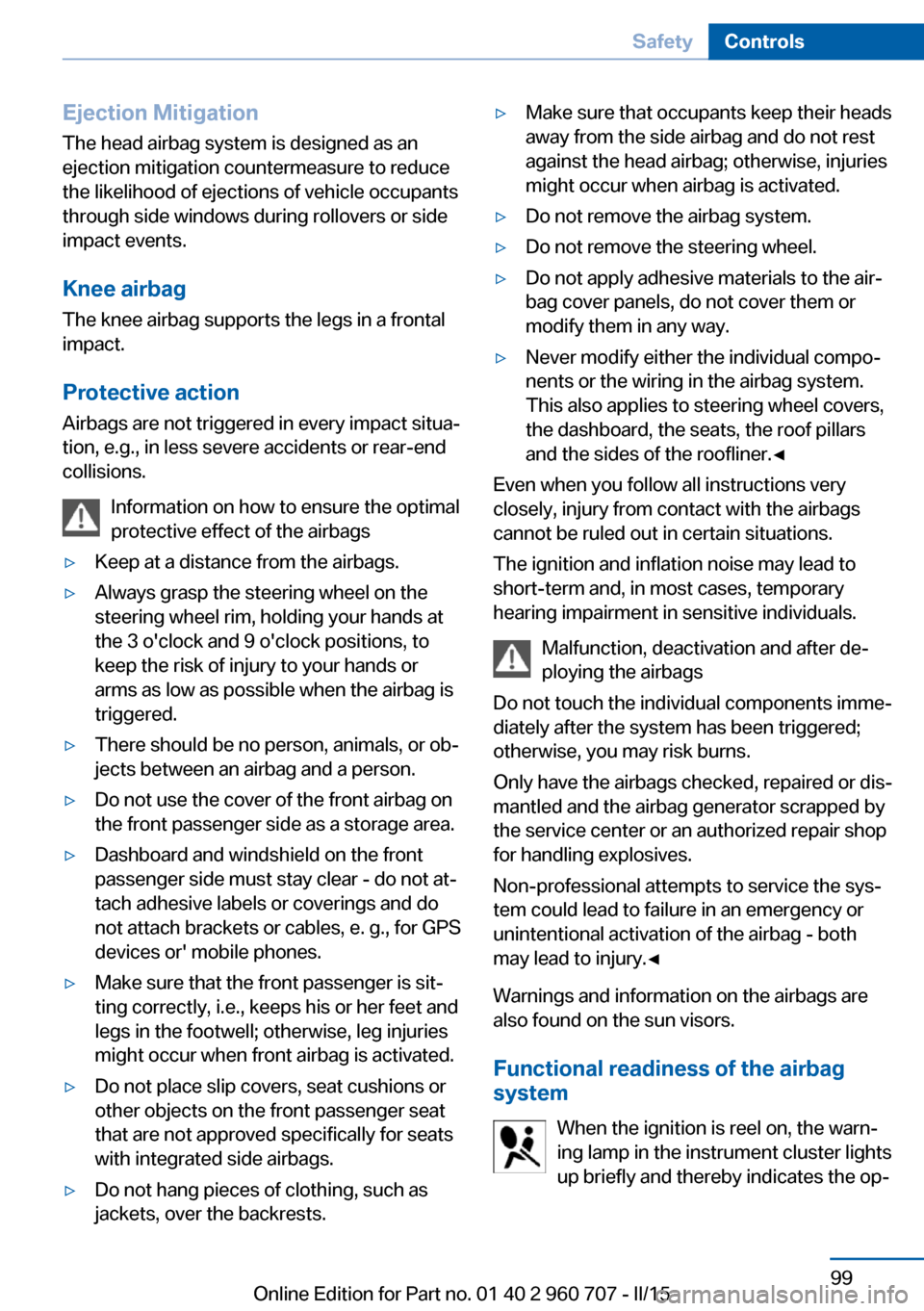
Ejection MitigationThe head airbag system is designed as an
ejection mitigation countermeasure to reduce
the likelihood of ejections of vehicle occupants
through side windows during rollovers or side
impact events.
Knee airbag The knee airbag supports the legs in a frontal
impact.
Protective action
Airbags are not triggered in every impact situa‚Äź
tion, e.g., in less severe accidents or rear-end
collisions.
Information on how to ensure the optimal
protective effect of the airbags‚Ė∑Keep at a distance from the airbags.‚Ė∑Always grasp the steering wheel on the
steering wheel rim, holding your hands at
the 3 o'clock and 9 o'clock positions, to
keep the risk of injury to your hands or
arms as low as possible when the airbag is
triggered.‚Ė∑There should be no person, animals, or ob‚Äź
jects between an airbag and a person.‚Ė∑Do not use the cover of the front airbag on
the front passenger side as a storage area.‚Ė∑Dashboard and windshield on the front
passenger side must stay clear - do not at‚Äź
tach adhesive labels or coverings and do
not attach brackets or cables, e. g., for GPS
devices or' mobile phones.‚Ė∑Make sure that the front passenger is sit‚Äź
ting correctly, i.e., keeps his or her feet and
legs in the footwell; otherwise, leg injuries
might occur when front airbag is activated.‚Ė∑Do not place slip covers, seat cushions or
other objects on the front passenger seat
that are not approved specifically for seats
with integrated side airbags.‚Ė∑Do not hang pieces of clothing, such as
jackets, over the backrests.‚Ė∑Make sure that occupants keep their heads
away from the side airbag and do not rest
against the head airbag; otherwise, injuries
might occur when airbag is activated.‚Ė∑Do not remove the airbag system.‚Ė∑Do not remove the steering wheel.‚Ė∑Do not apply adhesive materials to the air‚Äź
bag cover panels, do not cover them or
modify them in any way.‚Ė∑Never modify either the individual compo‚Äź
nents or the wiring in the airbag system.
This also applies to steering wheel covers,
the dashboard, the seats, the roof pillars
and the sides of the roofliner.‚óÄ
Even when you follow all instructions very
closely, injury from contact with the airbags
cannot be ruled out in certain situations.
The ignition and inflation noise may lead to
short-term and, in most cases, temporary
hearing impairment in sensitive individuals.
Malfunction, deactivation and after de‚Äź
ploying the airbags
Do not touch the individual components imme‚Äź
diately after the system has been triggered;
otherwise, you may risk burns.
Only have the airbags checked, repaired or dis‚Äź
mantled and the airbag generator scrapped by
the service center or an authorized repair shop
for handling explosives.
Non-professional attempts to service the sys‚Äź
tem could lead to failure in an emergency or
unintentional activation of the airbag - both
may lead to injury.‚óÄ
Warnings and information on the airbags are also found on the sun visors.
Functional readiness of the airbag
system
When the ignition is reel on, the warn‚Äź
ing lamp in the instrument cluster lights
up briefly and thereby indicates the op‚Äź
Seite 99SafetyControls99
Online Edition for Part no. 01 40 2 960 707 - II/15
Page 113 of 249
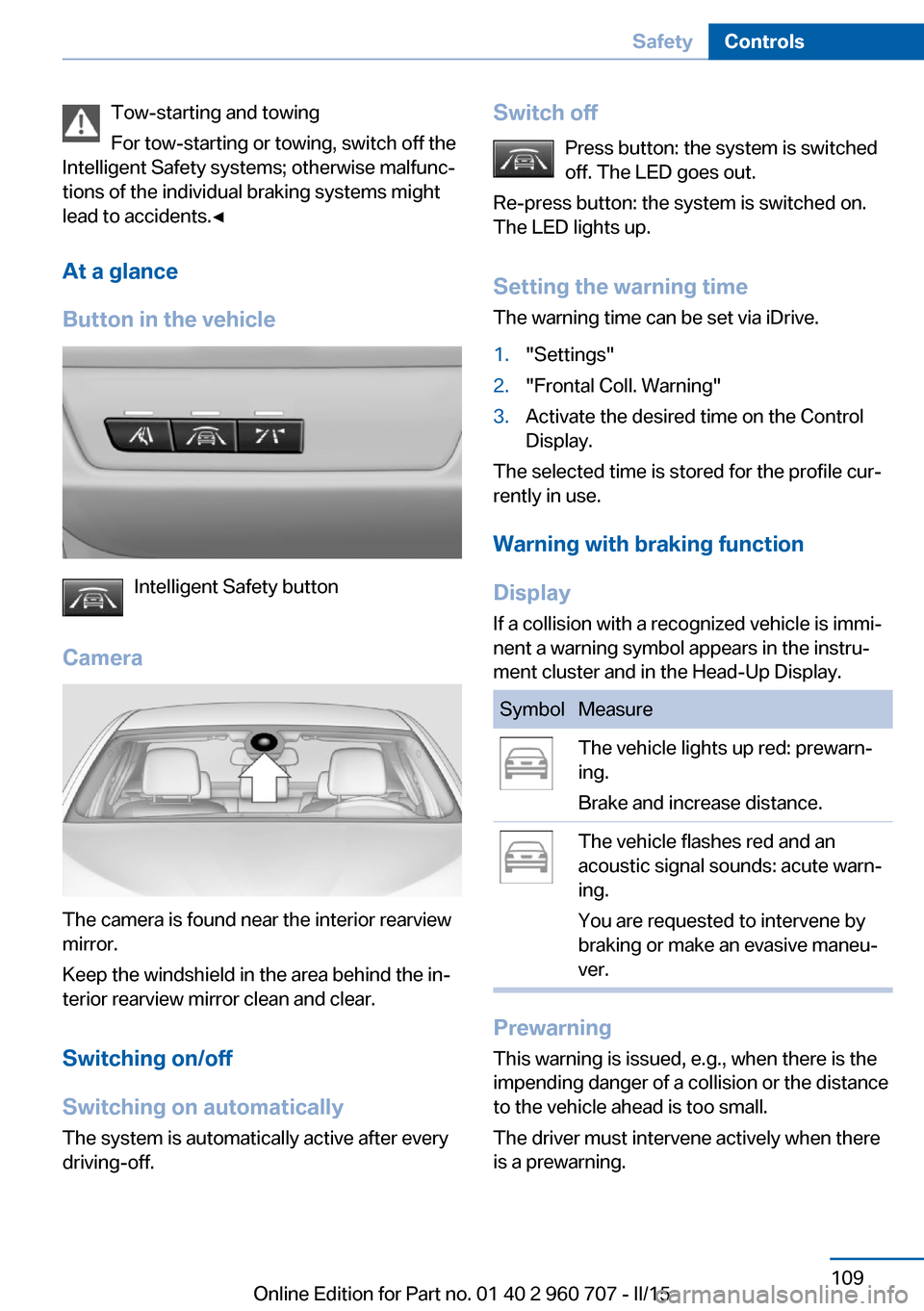
Tow-starting and towing
For tow-starting or towing, switch off the
Intelligent Safety systems; otherwise malfunc‚Äź
tions of the individual braking systems might
lead to accidents.‚óÄ
At a glance
Button in the vehicle
Intelligent Safety button
Camera
The camera is found near the interior rearview
mirror.
Keep the windshield in the area behind the in‚Äź
terior rearview mirror clean and clear.
Switching on/off
Switching on automatically The system is automatically active after every
driving-off.
Switch off
Press button: the system is switched
off. The LED goes out.
Re-press button: the system is switched on.
The LED lights up.
Setting the warning time The warning time can be set via iDrive.1."Settings"2."Frontal Coll. Warning"3.Activate the desired time on the Control
Display.
The selected time is stored for the profile cur‚Äź
rently in use.
Warning with braking function
Display If a collision with a recognized vehicle is immi‚Äź
nent a warning symbol appears in the instru‚Äź
ment cluster and in the Head-Up Display.
SymbolMeasureThe vehicle lights up red: prewarn‚Äź
ing.
Brake and increase distance.The vehicle flashes red and an
acoustic signal sounds: acute warn‚Äź
ing.
You are requested to intervene by
braking or make an evasive maneu‚Äź
ver.
Prewarning
This warning is issued, e.g., when there is the
impending danger of a collision or the distance
to the vehicle ahead is too small.
The driver must intervene actively when there
is a prewarning.
Seite 109SafetyControls109
Online Edition for Part no. 01 40 2 960 707 - II/15
Page 116 of 249
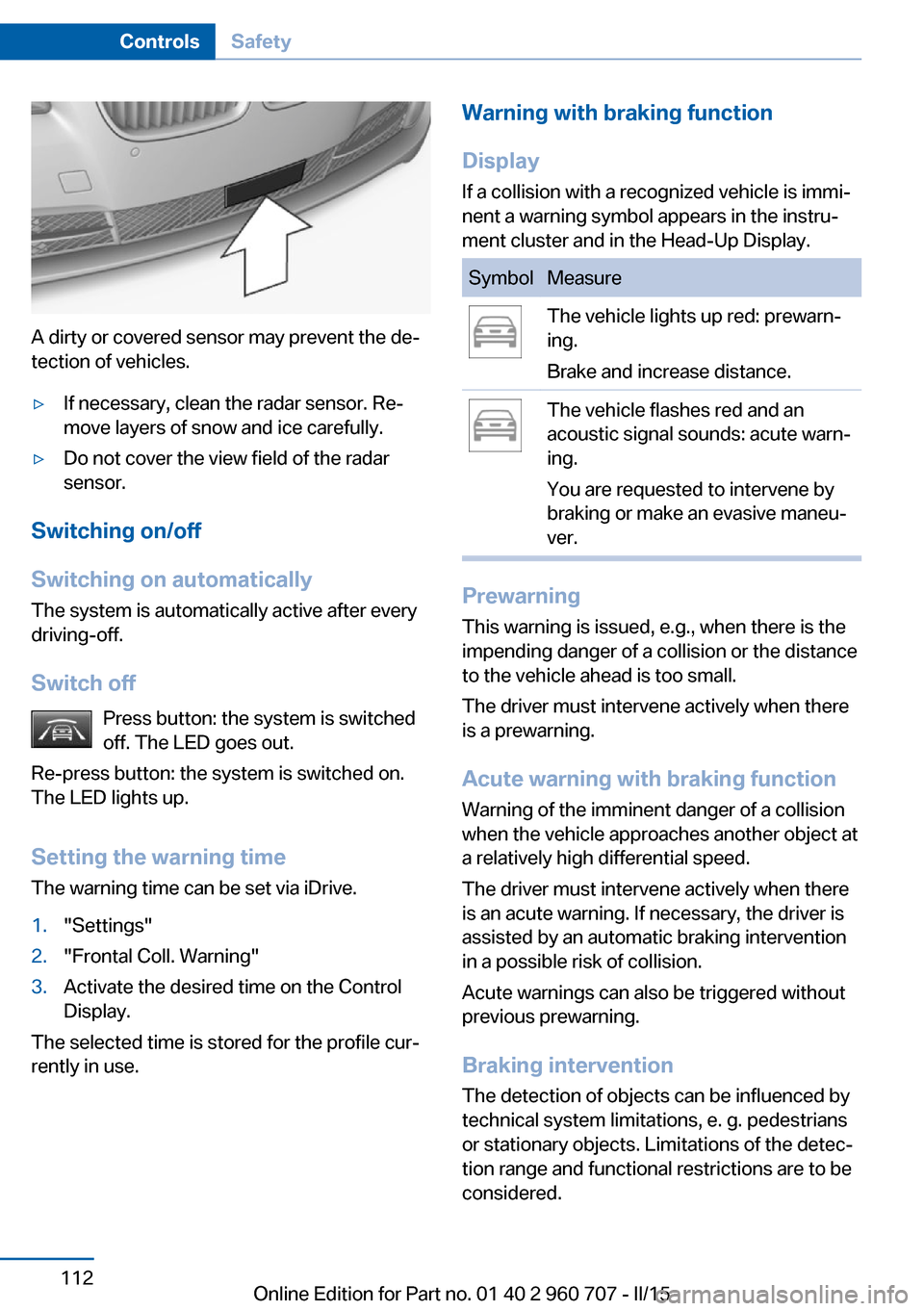
A dirty or covered sensor may prevent the de‚Äź
tection of vehicles.
‚Ė∑If necessary, clean the radar sensor. Re‚Äź
move layers of snow and ice carefully.‚Ė∑Do not cover the view field of the radar
sensor.
Switching on/off
Switching on automatically The system is automatically active after every
driving-off.
Switch off Press button: the system is switched
off. The LED goes out.
Re-press button: the system is switched on.
The LED lights up.
Setting the warning time The warning time can be set via iDrive.
1."Settings"2."Frontal Coll. Warning"3.Activate the desired time on the Control
Display.
The selected time is stored for the profile cur‚Äź
rently in use.
Warning with braking function
Display
If a collision with a recognized vehicle is immi‚Äź
nent a warning symbol appears in the instru‚Äź
ment cluster and in the Head-Up Display.SymbolMeasureThe vehicle lights up red: prewarn‚Äź
ing.
Brake and increase distance.The vehicle flashes red and an
acoustic signal sounds: acute warn‚Äź
ing.
You are requested to intervene by
braking or make an evasive maneu‚Äź
ver.
Prewarning
This warning is issued, e.g., when there is the
impending danger of a collision or the distance
to the vehicle ahead is too small.
The driver must intervene actively when there
is a prewarning.
Acute warning with braking function
Warning of the imminent danger of a collision
when the vehicle approaches another object at
a relatively high differential speed.
The driver must intervene actively when there
is an acute warning. If necessary, the driver is
assisted by an automatic braking intervention
in a possible risk of collision.
Acute warnings can also be triggered without
previous prewarning.
Braking intervention The detection of objects can be influenced by
technical system limitations, e. g. pedestrians
or stationary objects. Limitations of the detec‚Äź
tion range and functional restrictions are to be
considered.
Seite 112ControlsSafety112
Online Edition for Part no. 01 40 2 960 707 - II/15
Page 119 of 249

Switch offPress button: the systems are turned
off. The LED goes out.
Press button: the systems are turned on. The
LED lights up.
Warning with braking function
Display
If a collision with a person detected in this way
is imminent, a warning symbol appears on the
instrument cluster and in the Head-up Display.
The red symbol is displayed and a sig‚Äź
nal sounds.
Intervene immediately by braking or make an
evasive maneuver.
Braking intervention
The warning prompts the driver himself/herself
to react. During a warning, the maximum brak‚Äź
ing force is used. Premise for the brake boos‚Äź
ter is sufficiently quick and hard stepping on
the brake pedal. The system can assist with
some braking intervention if there is risk of a
collision. At low speeds vehicles may thus
come to a complete stop.
Manual transmission: During a braking inter‚Äź
vention up to a complete stop, the engine may
be shut down.
The braking intervention is executed only if
DSC Dynamic Stability Control is switched on
and Dynamic Traction Control DTC is acti‚Äź
vated.
The braking intervention can be interrupted by
stepping on the accelerator pedal or by ac‚Äź
tively moving the steering wheel.
Object detection can be restricted. Limitations
of the detection range and functional restric‚Äź
tions are to be considered.System limits
Detection range
The detection potential of the camera is lim‚Äź
ited.
Thus a warning might not be issued or be is‚Äź
sued late.
E. g. the following situations may not be de‚Äź
tected:‚Ė∑Partially covered pedestrians.‚Ė∑Pedestrians that are not detected as such
because of the viewing angle or contour.‚Ė∑Pedestrians outside of the detection range.‚Ė∑Pedestrians having a body size less than
32 in/80 cm.
Functional limitations
The system may not be fully functional or may
not be available in the following situations:
‚Ė∑In heavy fog, rain, sprayed water or snow‚Äź
fall.‚Ė∑In tight curves.‚Ė∑If the driving stability control systems are
deactivated, e.g. DSC OFF.‚Ė∑If the camera viewing field or the front
windshield are dirty or covered.‚Ė∑Up to 10 seconds after the start of the en‚Äź
gine, via the Start/Stop knob.‚Ė∑During calibration of the camera immedi‚Äź
ately after vehicle shipment.‚Ė∑If there is constant blinding effects be‚Äź
cause of oncoming light, e. g., from the sun
low in the sky.‚Ė∑When it is dark outside.
Lane departure warning
The concept Starting at a specific speed, this system alerts
you when the vehicle on streets with lane
markings is about to leave the lane. This
Seite 115SafetyControls115
Online Edition for Part no. 01 40 2 960 707 - II/15
Page 120 of 249
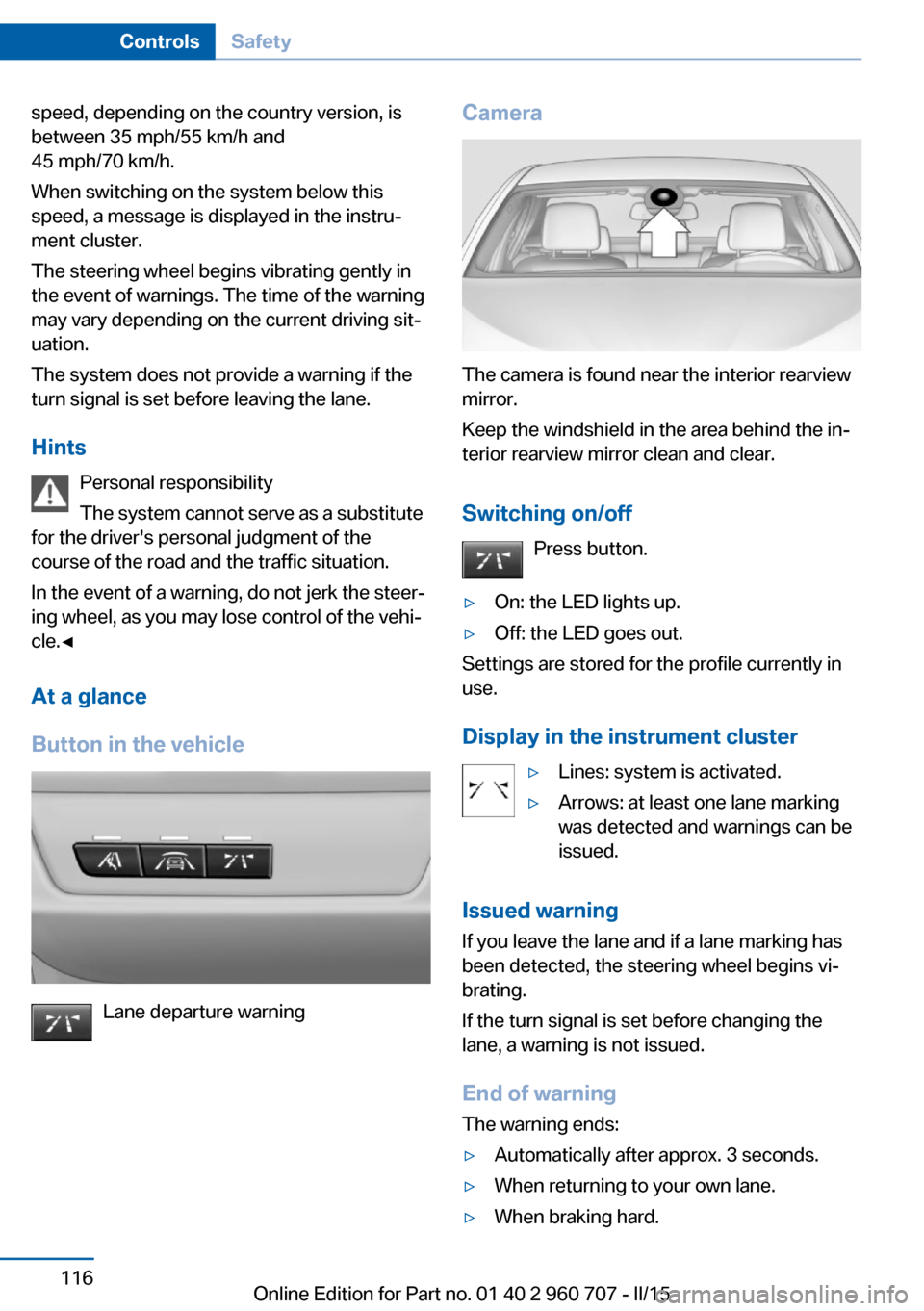
speed, depending on the country version, is
between 35 mph/55 km/h and
45 mph/70 km/h.
When switching on the system below this
speed, a message is displayed in the instru‚Äź
ment cluster.
The steering wheel begins vibrating gently in
the event of warnings. The time of the warning
may vary depending on the current driving sit‚Äź
uation.
The system does not provide a warning if the
turn signal is set before leaving the lane.
Hints Personal responsibility
The system cannot serve as a substitute
for the driver's personal judgment of the
course of the road and the traffic situation.
In the event of a warning, do not jerk the steer‚Äź
ing wheel, as you may lose control of the vehi‚Äź
cle.‚óÄ
At a glance
Button in the vehicle
Lane departure warning
Camera
The camera is found near the interior rearview
mirror.
Keep the windshield in the area behind the in‚Äź
terior rearview mirror clean and clear.
Switching on/off Press button.
‚Ė∑On: the LED lights up.‚Ė∑Off: the LED goes out.
Settings are stored for the profile currently in
use.
Display in the instrument cluster
‚Ė∑Lines: system is activated.‚Ė∑Arrows: at least one lane marking
was detected and warnings can be
issued.
Issued warning
If you leave the lane and if a lane marking has
been detected, the steering wheel begins vi‚Äź
brating.
If the turn signal is set before changing the
lane, a warning is not issued.
End of warning
The warning ends:
‚Ė∑Automatically after approx. 3 seconds.‚Ė∑When returning to your own lane.‚Ė∑When braking hard.Seite 116ControlsSafety116
Online Edition for Part no. 01 40 2 960 707 - II/15
Page 125 of 249

Indicator/warning lightsThe indicator lamp flashes: DSC con‚Äź
trols the drive and braking forces.
The indicator lamp lights up: DSC has
failed.
Deactivating DSC: DSC OFF When DSC is deactivated, driving stability is
reduced during acceleration and when driving
in curves.
To increase vehicle stability, activate DSC
again as soon as possible.
Deactivating DSC Press and hold this button but not lon‚Äź
ger than approx. 10 seconds, until the
indicator lamp for DSC OFF lights up in the in‚Äź
strument cluster and displays DSC OFF.
The DSC system is switched off.
The steering and, depending on the equip‚Äź
ment, suspension are tuned for sporty driving.
Activating DSC Press button.
DSC OFF and the DSC OFF indicator
lamp go out.
Indicator/warning lights
When DSC is deactivated, DSC OFF is dis‚Äź
played in the instrument cluster.
The indicator lamp lights up: DSC is
deactivated.
DTC Dynamic Traction
Control
The concept
The DTC system is a version of the DSC where
forward momentum is optimized.The system ensures maximum headway on
special road conditions or loose road surfaces,
e.g., unplowed snowy roads, but with some‚Äź
what limited driving stability.
Activating the Dynamic Traction Control DTC
provides maximum traction. Driving stability is
limited during acceleration and when driving in
curves.
Therefore drive with appropriate caution.
You may find it useful to briefly activate DTC
under the following special circumstances:‚Ė∑When driving in slush or on uncleared,
snow-covered roads.‚Ė∑When freeing vehicle from deep snow or
driving off from loose grounds.‚Ė∑When driving with snow chains.
Deactivating/activating DTC Dynamic
Traction Control
Activating DTC Press button.
TRACTION is displayed in the instru‚Äź
ment cluster and the indicator lamp for DSC
OFF lights up.
Deactivating DTC Press button again.
TRACTION and the DSC OFF indica‚Äź
tor lamp go out.
xDrive xDrive is the all-wheel-drive system of your ve‚Äź
hicle. Concerted action by the xDrive and DSC
further optimize traction and driving dynamics.
The xDrive all-wheel-drive system variably dis‚Äź
tributes the drive forces to the front and rear
axles as demanded by the driving situation and
road surface.
Seite 121Driving stability control systemsControls121
Online Edition for Part no. 01 40 2 960 707 - II/15
Page 127 of 249
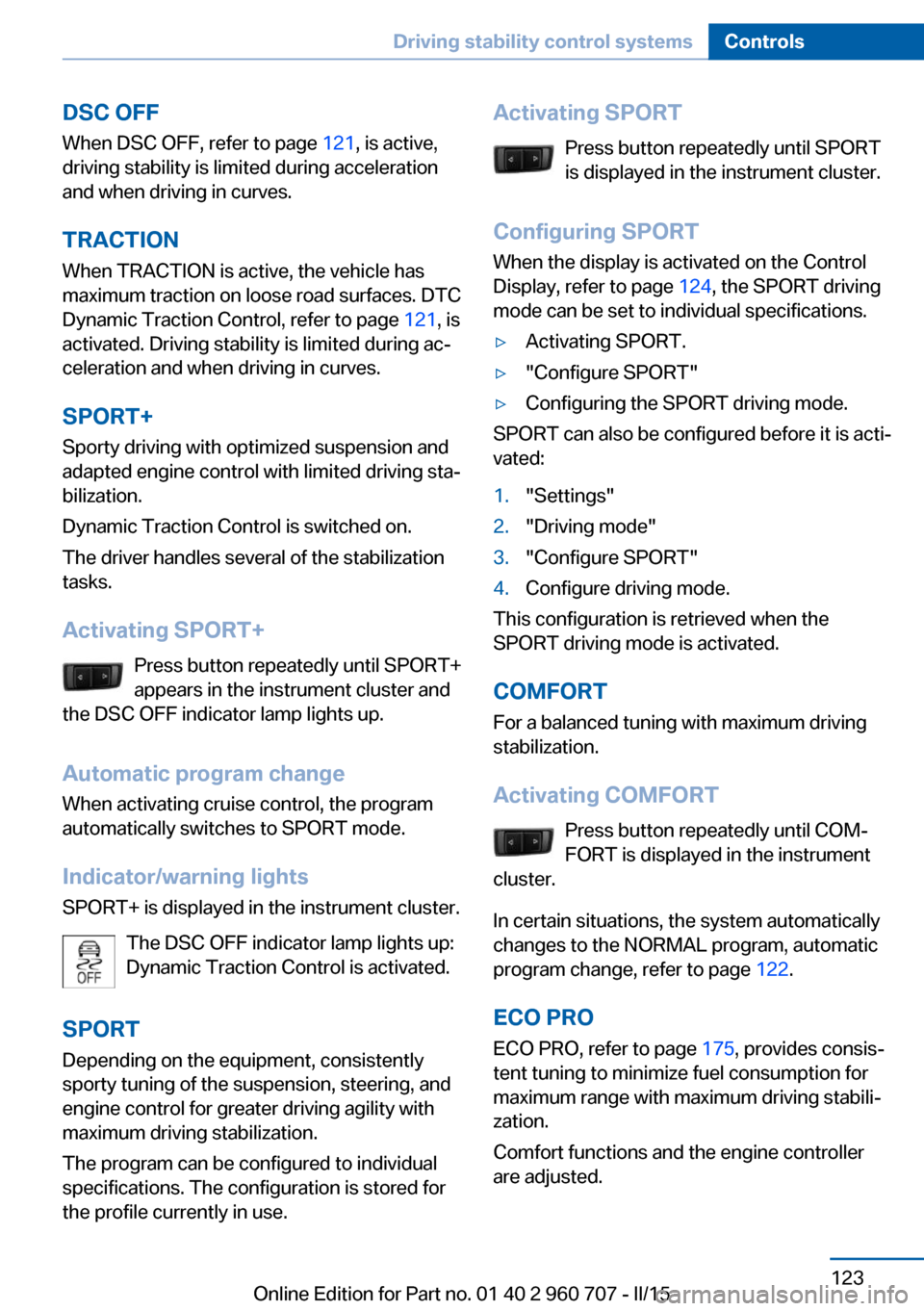
DSC OFFWhen DSC OFF, refer to page 121, is active,
driving stability is limited during acceleration
and when driving in curves.
TRACTION When TRACTION is active, the vehicle has
maximum traction on loose road surfaces. DTC
Dynamic Traction Control, refer to page 121, is
activated. Driving stability is limited during ac‚Äź
celeration and when driving in curves.
SPORT+
Sporty driving with optimized suspension and
adapted engine control with limited driving sta‚Äź
bilization.
Dynamic Traction Control is switched on.
The driver handles several of the stabilization
tasks.
Activating SPORT+ Press button repeatedly until SPORT+
appears in the instrument cluster and
the DSC OFF indicator lamp lights up.
Automatic program change When activating cruise control, the program
automatically switches to SPORT mode.
Indicator/warning lights
SPORT+ is displayed in the instrument cluster.
The DSC OFF indicator lamp lights up:
Dynamic Traction Control is activated.
SPORT Depending on the equipment, consistently
sporty tuning of the suspension, steering, and
engine control for greater driving agility with
maximum driving stabilization.
The program can be configured to individual
specifications. The configuration is stored for
the profile currently in use.Activating SPORT
Press button repeatedly until SPORT
is displayed in the instrument cluster.
Configuring SPORT When the display is activated on the Control
Display, refer to page 124, the SPORT driving
mode can be set to individual specifications.‚Ė∑Activating SPORT.‚Ė∑"Configure SPORT"‚Ė∑Configuring the SPORT driving mode.
SPORT can also be configured before it is acti‚Äź
vated:
1."Settings"2."Driving mode"3."Configure SPORT"4.Configure driving mode.
This configuration is retrieved when the
SPORT driving mode is activated.
COMFORT For a balanced tuning with maximum driving
stabilization.
Activating COMFORT Press button repeatedly until COM‚Äź
FORT is displayed in the instrument
cluster.
In certain situations, the system automatically
changes to the NORMAL program, automatic
program change, refer to page 122.
ECO PRO ECO PRO, refer to page 175, provides consis‚Äź
tent tuning to minimize fuel consumption for
maximum range with maximum driving stabili‚Äź
zation.
Comfort functions and the engine controller
are adjusted.
Seite 123Driving stability control systemsControls123
Online Edition for Part no. 01 40 2 960 707 - II/15
Page 128 of 249

The program can be configured to individual
specifications.
Activating ECO PRO Press button repeatedly until ECO
PRO is displayed in the instrument
cluster.
Configuring ECO PRO1.Activate ECO PRO.2."Configure ECO PRO"
Make the desired settings.
Configuring driving program Settings can be made for the following driving
programs in Driving mode:
‚Ė∑SPORT, refer to page 123.‚Ė∑ECO PRO, refer to page 176.
Displays
Program selection Pressing the button displays a
list of the selectable programs.
Depending on your vehicle's op‚Äź
tional features, the list in the in‚Äź
strument cluster can differ from
the illustration shown.
Selected program The instrument cluster displays
the selected program.
Display on the Control Display Program changes can be displayed on the
Control Display.
1."Settings"2."Control display"3."Driving mode info"
Drive-off assistant
This system supports driving off on inclines.
The parking brake is not required.
1.Hold the vehicle in place with the foot
brake.2.Release the foot brake and drive off with‚Äź
out delay.
After the foot brake is released, the vehicle is
held in place for approx. 2 seconds.
For vehicles with respective equipment ver‚Äź
sions, the possible holding duration amounts
to 2 minutes.
Depending on the vehicle load or when a trailer
is used, the vehicle may roll back slightly.
Driving off without delay
After releasing the foot brake, start driv‚Äź
ing without delay, since the drive-off assistant
will not hold the vehicle in place for more than
approx. 2 seconds and the vehicle will begin to
roll back.‚óÄ
Servotronic The conceptThe Servotronic varies the steering force re‚Äź
quired to turn the wheels in accordance with
the vehicle speed. At low speeds, the steering
force is strongly supported, i. e. during steer‚Äź
ing, low force is required. As the speed in‚Äź creases, the assistance of the steering force is
reduced.
Furthermore, the steering force adapts accord‚Äź
ing to the driving program, so that a direct, sporty feel and/or comfortable steering is con‚Äź
veyed.
Seite 124ControlsDriving stability control systems124
Online Edition for Part no. 01 40 2 960 707 - II/15
Page 130 of 249
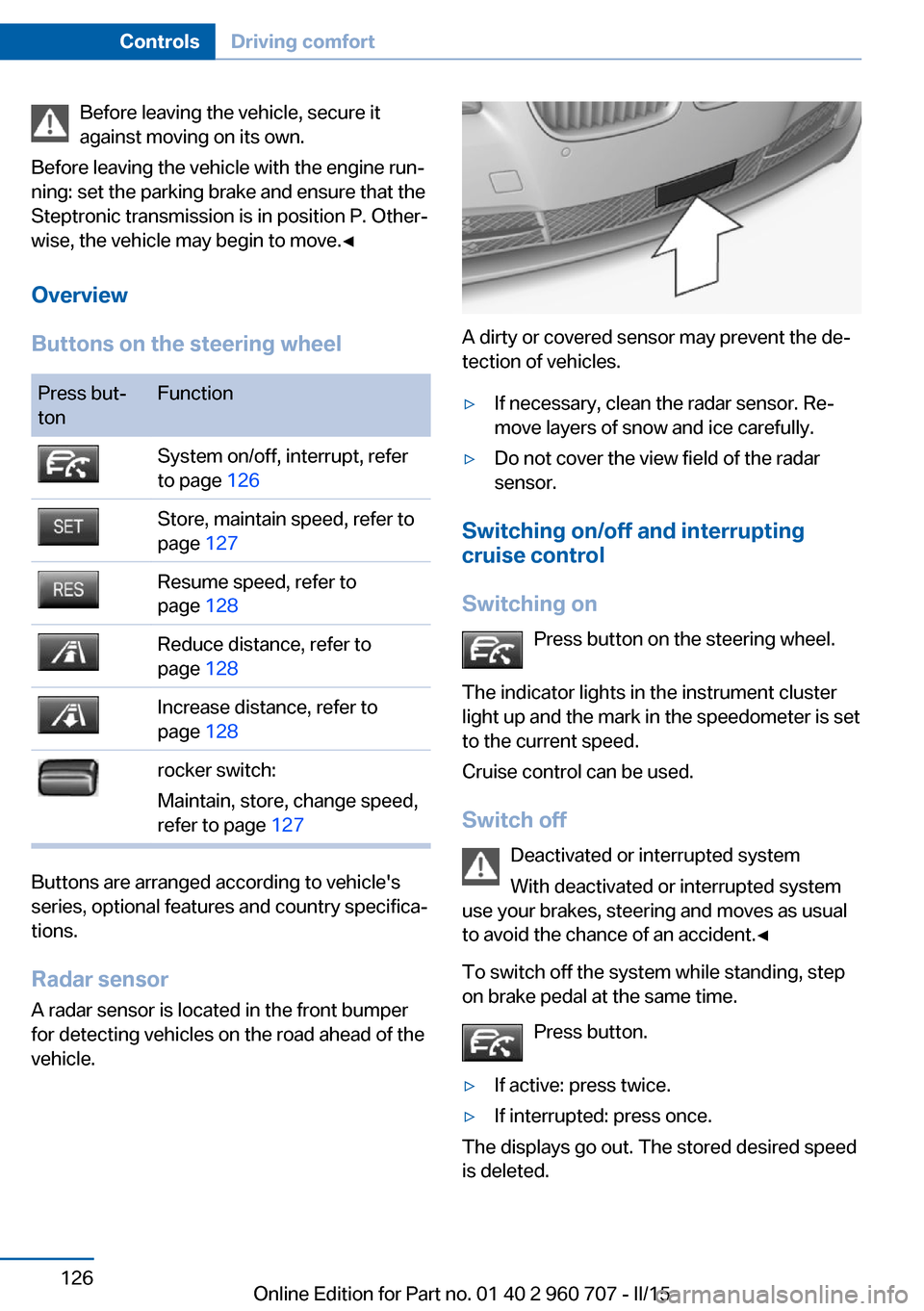
Before leaving the vehicle, secure it
against moving on its own.
Before leaving the vehicle with the engine run‚Äź
ning: set the parking brake and ensure that the
Steptronic transmission is in position P. Other‚Äź
wise, the vehicle may begin to move.‚óÄ
Overview
Buttons on the steering wheelPress but‚Äź
tonFunctionSystem on/off, interrupt, refer
to page 126Store, maintain speed, refer to
page 127Resume speed, refer to
page 128Reduce distance, refer to
page 128Increase distance, refer to
page 128rocker switch:
Maintain, store, change speed,
refer to page 127
Buttons are arranged according to vehicle's
series, optional features and country specifica‚Äź
tions.
Radar sensor
A radar sensor is located in the front bumper for detecting vehicles on the road ahead of the
vehicle.
A dirty or covered sensor may prevent the de‚Äź
tection of vehicles.
‚Ė∑If necessary, clean the radar sensor. Re‚Äź
move layers of snow and ice carefully.‚Ė∑Do not cover the view field of the radar
sensor.
Switching on/off and interrupting cruise control
Switching on Press button on the steering wheel.
The indicator lights in the instrument cluster
light up and the mark in the speedometer is set
to the current speed.
Cruise control can be used.
Switch off Deactivated or interrupted system
With deactivated or interrupted system
use your brakes, steering and moves as usual
to avoid the chance of an accident.‚óÄ
To switch off the system while standing, step
on brake pedal at the same time.
Press button.
‚Ė∑If active: press twice.‚Ė∑If interrupted: press once.
The displays go out. The stored desired speed
is deleted.
Seite 126ControlsDriving comfort126
Online Edition for Part no. 01 40 2 960 707 - II/15
Page 131 of 249

InterruptingWhen active, press the button.
If interrupting the system while stationary,
press on the brake pedal at the same time.
The system is automatically interrupted in the
following situations:‚Ė∑When the brakes are applied.‚Ė∑When selector lever position D is disen‚Äź
gaged.‚Ė∑When DTC Dynamic Traction Control is
activated or DSC is deactivated.‚Ė∑When DSC is actively controlling stability.‚Ė∑When SPORT+ is activated with Driving
Dynamics Control.‚Ė∑If the safety belt and the driver's door are
opened while the vehicle is standing still.‚Ė∑If the system has not detected objects for
an extended period, e.g., on a road with
very little traffic without curb or shoulder
markings.‚Ė∑If the detection range of the radar is dis‚Äź
rupted, e.g., by dirt or heavy fog.
Maintaining, storing, and changing the
speed
Hints Adjusting the desired speedModify desired speed to road conditions
and be ready to brake at all times; otherwise,
there is the risk of an accident.‚óÄ
Differences in speed
Large differences in speed relative to ve‚Äź
hicles ahead of the vehicle cannot be compen‚Äź
sated by the system for example in the follow‚Äź
ing situations:
‚Ė∑When fast approaching a slowly moving
vehicle.‚Ė∑When another vehicle suddenly swerves
into the wrong lane.‚óÄMaintaining/storing the speed
Press button.
Or:
Press the rocker switch while the system is in‚Äź
terrupted.
When the system is switched on, the current
speed is maintained and stored as the desired
speed.
This is displayed in the speedometer and
briefly in the instrument cluster. Displays in the
instrument cluster, refer to page 128.
When cruise control is maintained or stored,
DSC Dynamic Stability Control will be turned
on if needed.
Changing the speed
Press the rocker switch up or down repeatedly
until the desired speed is set.
If active, the displayed speed is stored and the vehicle reaches the stored speed when the
road is clear.
‚Ė∑Each time the rocker switch is pressed to
the point of resistance, the desired speed
increases or decreases by approx.
1 mph/1 km/h.‚Ė∑Each time the rocker switch is pressed
past the point of resistance, the desired
speed increases or decreases by a maxi‚Äź
mum of 5 mph/10 km/h.
Hold the rocker switch in position to repeat the
action.
Seite 127Driving comfortControls127
Online Edition for Part no. 01 40 2 960 707 - II/15